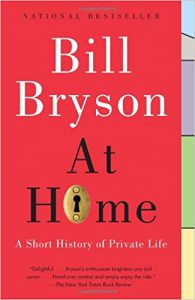At Home: A Short History of Private Life, by Bill Bryson
At Home: A Short History of Private Life
By Bill Bryson
Doubleday
Five stars
Reviewed by Jessica Gribble
Bill Bryson is best loved for his travel writing. Readers love to amble along with him on various adventures: through-hiking the Appalachian Trail (A Walk in the Woods), confronting deadly animals in the Australian outback (In a Sunburned Country), or sipping tea in England (Notes from a Small Island). However, he also writes about language and science, biographies, history, and even memoir. No matter the genre, Bryson never fails to amuse and delight.
At Home is full of history, neatly hung on the literary frame of a house tour. It’s Bryson’s house that we have the privilege of touring: a Victorian parsonage in a town where nothing much has happened for centuries except “people quietly going about their daily business – eating, sleeping, having sex, [and] endeavoring to be amused.” Bryson begins At Homewith the story of wriggling through a ceiling hatch into the attic, only to find a strange door that turns out to lead to the rooftop.
Why is there a door out onto the roof, especially since there are no stairs up to the attic, making the whole procedure of getting out there singularly complicated? Bryson gazes out on the fields that surround the house, delighted to see his world from a brand-new perspective. But the questions about the architecture of the house, once raised, continue to nag him.
Once back indoors, he looks around and discovers that he’s never paid much attention to domestic life. For instance, why do salt and pepper (as opposed to salt and cinnamon, or pepper and cardamom) appear on every table? Why do suit jackets have a row of pointless buttons on the sleeves? What the heck is room and board? The rest of the book is a tour through the history of homes and creature comforts.
In true Brysonian style, we end up learning about government, architecture, industry, food, war, inventions, disease, the economy, leisure, and science. And much of it is very funny!
Good historians—good writers of any sort—don’t just dump information on readers and hope it sticks. Each new discovery leads Bryson into the next discovery; for instance, an explanation of the horrors of mid-nineteenth century graveyards, into which bodies were sometimes piled to a density of one hundred thousand per acre, leads to the invention of the modern city park.
One literary trick Bryson has mastered is drawing attention to repeated information so that readers are startled by the delight of recognition. A particular year pops up numerous times, and we start to think “oh-ho! It’s good old 1851 again!” Various people, like Joseph Paxton, who designed the Crystal Palace, turn up again and again, and Bryson, wearing his professor hat, points them out so we’ll remember (and feel smart). Bryson did a massive amount of reading on our behalf: the bibliography runs to more than 25 pages.
Occasionally the literary framework of a walk through the parsonage feels a little forced. A new chapter means a new room of the house, and sometimes emerging from the historical material leaves you blinking and disoriented to be back in the present. Bryson’s whirlwind tour of the development of the creature comforts we’ve all come to rely upon, from indoor plumbing to modern medicine to embroidered lingerie, reminds us that human beings are remarkable inventors who have, unfortunately, often tried to keep the pleasures of life accessible to only the privileged wealthy. Whether our pioneering spirit or our greedy selfishness will win out over time is the subject for another book – and we can only hope that the incomparable traveler, historian, and humorist Bill Bryson will write it.
